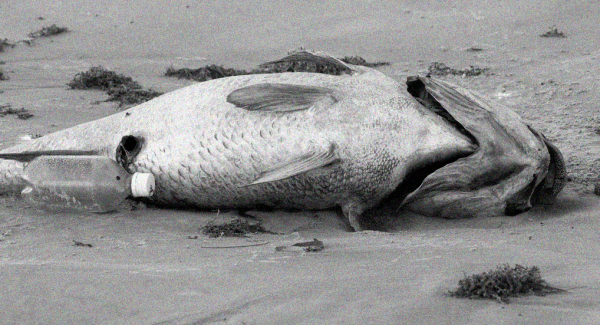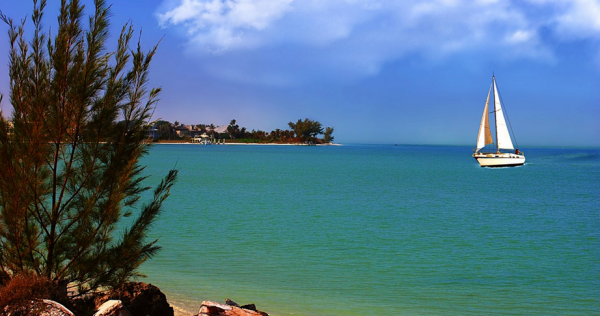[dropcap]N[/dropcap]orm warned me that I might see some dead fish. It was spring of 2004 and I was on Sanibel Island looking for a snook or two cruising the beaches near where Norm Zeigler’s fly shop was located. He told me that the area recently suffered an outbreak of red tide, one form of a dangerous toxic algae bloom that not only threatens the health of local residents, but sucks the oxygen from the surrounding water leaving a multitude of dead fish that had been trapped in this web of life-snuffing pollution. So, when I got to the water, at least I was prepared for what I was about to see.
Upon getting out of my vehicle it was the putrid stench that awakened my senses even before walking along the shoreline to witness a variety of fish floating belly-up in the shallows poaching in the eighty-degree heat. As I proceeded several yards up the beach, my eyes locked in on a huge one-hundred and fifty pound goliath grouper smoldering in the sun parked about fifty feet from the porch of a beautiful waterfront house emanating a retched stink that most certainly was permeating the indoor sanctity of the home owner.
In an instant, my mind flashed back to the days of my youth in the 50s when such sights were commonplace on the Niagara River. Lifeless carp tangled in a carpet of thick, green slime stretching far along the dismal appearing shoreline was a way of life back then. And while the reek of fetid fish flesh wafted through an otherwise perfect Western New York summer afternoon, gagging for a breath of fresh air was the only way my friends and I could “enjoy” exploring the river’s edge. As kids we had no way of knowing that this was not normal.
I recalled a day when my cousin Paul dared to wade through the green sludge of carp stew where he found a yellow bullhead writhing on the edge of this witch’s brew. It was barely alive and covered with a fuzzy gray fungus. My friend Johnny Joe was standing next to me on a rock embankment. As a prank Paul used his thumb and forefinger to pick up the whiskered fish by the tail and lob it in our direction. My friend didn’t see it coming, but he screamed holy hell when the bullhead’s spinney dorsal fin pierced his upper arm and hung there like a crucifix. The grotesque creature wriggled. Johnny Joe ran. And I was dumbfounded. Lake Erie was dying, and so was the Niagara. I didn’t know that at the time. In a very real way the River was stolen from my youth, and that bullhead squirming on my friend’s arm hung as testimony to an ecosystem struggling at death’s door thanks to the wanton practices of unchecked industrial plunder.

Amended photo courtesy of Terry Ross. Licensing info here.
After spending much of my adult life trying to find water that wasn’t impacted by man’s errant activities, on that May afternoon I have to admit that the Sanibel beach experience triggered a PTSD type of reaction. To the core I was pissed. When I quizzed Norm about the background of the problem, it sounded extremely complex. What I did understand, however, was that the situation was connected to the heavily subsidized sugar industry and its ability to control legislators on the state and federal levels for decades. At that time these red tide occurrences were intermittent, and according to Norm, he and many other business leaders were led to believe that there were fixes in the works aimed at preventing these atrocities from happening again. But from my point of view, it was beyond incomprehensible that even one of these events had occurred without major backlash.
As I noted to Norm, folks spend a lot of time, money and effort to visit Florida. I know for darn sure smelling rotten fish is not part of the deal. I then asked how it was even possible in this day and age that one industry could impact the investments of so many homeowners and threaten the livelihoods of so many businesses without any pushback. If I lived there, I told him, my first instinct would be to take a load of these dead stinkers and throw them on the lawns of the legislators and sugar CEOs who are ignoring the rights of other taxpaying citizens and the tourists who bring substantial money into the state.
To tell the truth, I dismissed this depressing experience as a onetime glitch in a system that would surely be fixed as soon as any reasonable group of lawmakers caught wind of a situation that smelled to high heaven. For certain they could understand what the value a vibrant fishing industry meant to Florida’s overall tourism economy. Once they realized the Golden Goose was dying, undoubtedly any legislator with a functioning brain would step in and demand change. But it was not until 2017 when I saw a national news report featuring thousands of fish floating in the St. Lucie River as a result of the sugar industry’s transgressions that I realized not one thing had been done since 2004 to mitigate the destructive forces killing Florida waterways. For the sake of an industry estimated at anywhere between 500 million and 1.5 billion dollars per year Florida’s 10 billion dollar sport fishing industry and the property values of a substantive number of residents were being ravaged by a political industrial juggernaut that apparently could not give a dam about the rights of everyday citizens. After my experience growing up in the Great Lakes, it was hard to believe that this type of open environmental degradation could ever be allowed to occur again in the United States. How could this happen?
In a quick summary, it all focuses around the massive but shallow Lake Okeechobee in south central Florida. In the days before man settled the state, the overflow of fresh water from the Lake would percolate on through the massive marshland and mangrove forests while nourishing multitudes of life forms and replenishing the aquifer that would eventually provide drinking water for the Miami area. This vibrant ecosystem impacted the web of life all the way to the Florida Keys. But when settlement was expanded in the Sunshine State, the federal government drained portions of the giant marsh through a series of dredged canals that then made the coastal regions of the state habitable in the 20s. In 1931 Charles Stewart Mott founded US Sugar after the upper portion of the marsh below Lake Okeechobee was also drained and set aside for producing sugar cane. Although the resulting land provided poor quality growing conditions, the heavy usage of phosphates and nitrates made it possible, especially after factoring in subsidies from the federal government which, by the mid 30s, protected the marginal industry by federal law. After the Cuban revolution in 1959 resulted in an embargo on Cuban sugar imports, a Cuban sugar magnate refugee Alfonso Fanjul came to the states and essentially took over a large portion of Florida’s industry as more swamps were drained using dikes, levees and pumps to grow more cane. This land has officially been designated the Everglades Agricultural Area (EAA). Over time his family run enterprise became a powerful entity and now controls much of what goes on in southern Florida. Through political wrangling and campaign funding of politicians on both sides of the aisle, the sugar industry has subsequently influenced water management for decades while the balance of Florida’s citizens and its tourism industry suffer the consequences.
The only portion of southern Florida that had escaped total degradation was the Everglades National Park given protected status in 1947. But unfortunately the Everglades has been languishing from the fallout of big sugar activities over the years as well. The Park is not getting the free flow of fresh water needed from the northern marshes that is controlled by the industry, thus threatening much of its ecosystem. These days much of the water once destined for the Everglades is held back in Lake Okeechobee by the Herbert Hoover Dam. There, regulated amounts of water are released to the cane fields for irrigation. However, when the water level behind the dam gets too high, the excess is redirected to the St. Lucie River that empties into the Atlantic past the coastal city of Stuart and also into the Caloosahatchee River that runs westward past Sanibel Island and out to the Gulf of Mexico. Because of the shallow nature of the lake the phosphate level deposited over the years through back pumping water from the EAA is extremely concentrated. As a consequence this nutrient laced release produces toxic algae growth in the freshwater estuaries and various forms of red tide algae blooms in the saltwater. Some of these blooms are capable of killing any life caught in the polluted web, and over the past decade it would seem that the situation has hit critical mass.

Folks spend a lot of time, money and effort to visit Florida.
In 2017 SB10 was passed by Florida’s legislature and it accelerates planning and provides funding for an EAA reservoir that, according to the Comprehensive Everglades Restoration Plan, will provide needed water storage, treatment, and conveyance south of Lake Okeechobee. The plan is to reduce harmful discharges to the estuaries and send treated water south to the Everglades and Florida Bay. Some believe, however, this plan is not ambitious enough and will still result in toxic discharges into the St. Lucie and Caloosahatchee Rivers in the future. Updated information can be obtained from Bullsugar.org – a group dedicated to protecting Florida’s waterways while promoting the #NowOrNeverglades petition. The Now or Neverglades coalition includes but acts independent of the Everglades Foundation and is “the unifying voices of Florida and visitors, local, state and national elected officials, families, boat captains, fishermen and environmental conservation groups, Republicans and Democrats, and businesses – small and large – who have come together to save America’s Everglades and Florida’s water.”
In June 1969 Ohio’s Cuyahoga River, a Lake Erie tributary, caught on fire. This was not the first time the river had burned, but it would be the last. The residents of Cleveland spoke out. Finally the citizens of Ohio had enough of the industrial pollution that they had endured for decades in the name of progress. The time was right for change. Because President Richard Nixon had run his 1968 campaign on cleaning up the environment, Cleveland mayor Carl Stokes capitalized on the burning river story that made the cover of Time magazine. Along with his brother, US representative Louis Stokes, they instigated a push for federal involvement in national pollution control. In 1970 the National Environmental Policy Act was initiated that resulted in the formation of the Environmental Protection Agency. The agency then advocated for the Clean Water Act, which was signed into law by President Nixon in 1972. As a consequence, that very piece of legislation has led to major water reclamation projects throughout the United States since that time. Thanks to the environmental movement that started in 1970 the extensive Great Lakes basin is now a vastly improved ecosystem and a significant economic driving force for the entire region. Although the Great Lakes are still not free from continued environmental threats, there are no longer dead, bloated carp and dying, fuzzy bullheads floating in the Niagara River either.
The way I see it, the St Lucie River, the Caloosahatchee River and the Everglades are all burning, we just can’t see the flames. Enough is enough. Now is the time for a change
Featured image, Red Tide Rising by Bill Sutton.
Click here to purchase Jerry Kustich’s books on Amazon or visit his page on Facebook to learn more about him.


